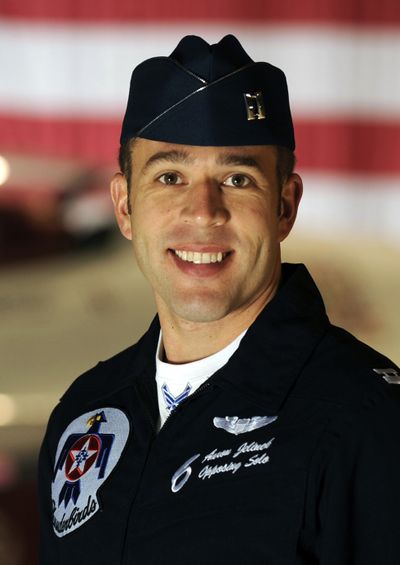For Captain, SkyFest will be a high-flying homecoming
Pilot raised in Spokane, Clarkston

When former Midway Elementary student Aaron Jelinek returns to Spokane later this month, his ride will turn heads.
It’s an F-16 fighter jet.
Now 30 and an Air Force captain, Jelinek is one of six Thunderbird aerobatic pilots who will perform at the July 24-25 Fairchild Air Force Base air show.
“I got chills when I saw the schedule come out and Fairchild was on it,” Jelinek said in a recent interview.
Not only did Jelinek attend Midway Elementary in the Mead School District before moving to Clarkston, he spent a year at Fairchild when he joined the Air Force nine years ago.
Jelinek entered the service through the ROTC program at Embry-Riddle Aeronautical University in Prescott, Ariz.
He will have his own cheering squad for the air show, including grandfather Don Thomason, who used to take him to air shows at Fairchild.
Jelinek said Thomason flew P-51 Mustangs in World War II and inspired him to become a pilot.
Thomason and his wife, Ortha, live in Spokane, as do uncle Dave Jelinek and his wife, Cora, and grandfather Emmett McLaughlin.
Others planning to attend the air show are Jelinek’s parents, Paul and Connie Jelinek, of Helena, brother Adam Jelinek and his wife, Jenny, of Lewiston, and several childhood friends from Clarkston.
Jelinek graduated from high school in Clarkston, where he lettered in track, football and basketball.
“It’s just awesome to have the support that I have with my family, my friends and all the e-mails that I’ve been getting that say, ‘Hey, we’re excited to come up. We’re looking forward to seeing you,’ ” Jelinek said. “That means so much to me.”
He joined the Thunderbirds in October after combat duty in Iraq, and is in his first year of a standard two-year assignment. As one of two “solo” pilots on the team, Jelinek’s role is to break away from the group and race 500 mph toward the other soloist, Maj. Rick Goodman, as though they were enemy combatants.
Jelinek said Goodman flies a fixed “center line,” and “my job is to put my jet where I need to be” – close enough to make the maneuver exciting, far enough to make it safe.
It may look closer from the ground, but the planes are about 50 feet apart when they pass. Even so, Jelinek said, it “isn’t that far apart when you’re approaching each other at 1,000 miles per hour.”
The other four pilots will demonstrate the capabilities of the F-16 with precision flying in which their aircraft sometimes are just 18 inches apart.
The Thunderbirds’ planes are unmodified except that their guns have been removed to provide room for smoke-making oil canisters. The fighters can be combat-ready in 72 hours.
For the final three maneuvers of the show, the solo pilots rejoin the squadron and change its diamond formation into a wedge-shaped delta.
The flying is not as scary as it looks, Jelinek said. “Safety is our No. 1 priority.”
Before each show, team members survey the area for tall structures, hills, rising terrain, birds and other potential hazards. They also practice the show two or three times a day from November through March.
The Fairchild show will be the 25th of the 73 the Thunderbirds will perform this year in the United States and Canada. Based at Nellis Air Force Base in Las Vegas, the Thunderbirds are away from home nearly 200 days a year.
“The separation from family is fairly difficult at times,” Jelinek said, but his wife, Terri, often accompanies him. “We try to get her to as many shows as we can.”
Performances begin on the ground, where crewmen demonstrate behind-the-scenes work. Each Thunderbird pilot has a crew chief and an assistant who perform three to five hours of maintenance for 35 minutes of flying in each show.
“These guys are the best of the best when it comes to taking care of aircraft,” Jelinek said. “That’s one of the best things about being on the team. You get to work with 120 of the best enlisted personnel in the Air Force.”
Although Air Force pilots usually perform their own flight checks, Thunderbird crew chiefs assume that duty for shows.
Jelinek said he confidently places his life in the hands of his crew chief, Staff Sgt. Paul Hooks, and Hooks’ assistant, Staff Sgt. Joe Delos Santos.
“I trust that every single switch is in the right position and I’m ready to start,” Jelinek said.
When a show ends, Jelinek, Hooks, Delos Santos and their colleagues work the crowd along with recruiters. They sign autographs, hand out brochures and photographs, and answer questions.
“The whole team is responsible for representing nearly 700,000 American airmen,” Jelinek said. “What we’re really out there for is telling the Air Force story.
“That’s what I enjoy more than anything.”